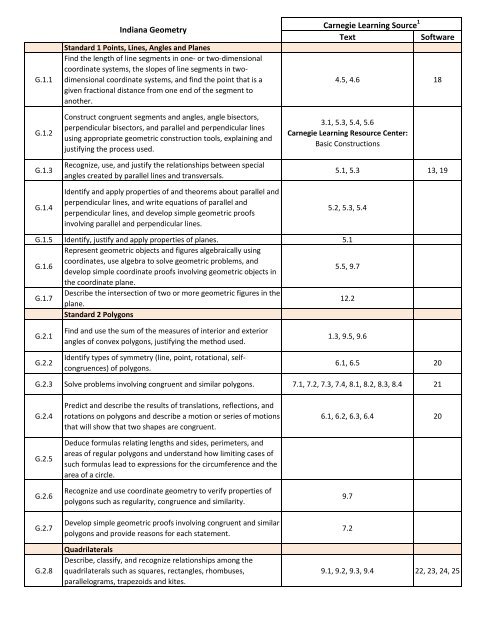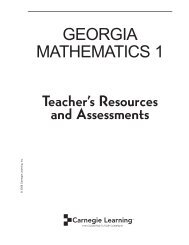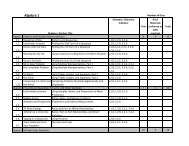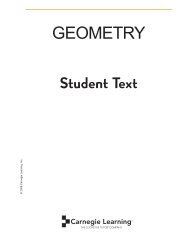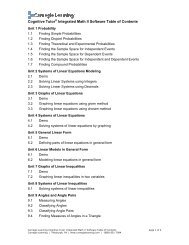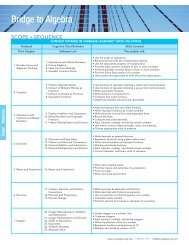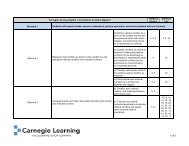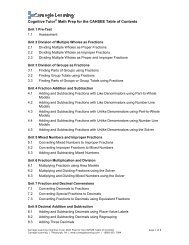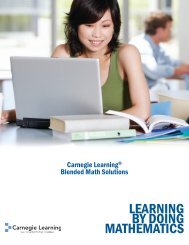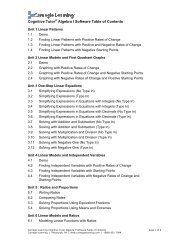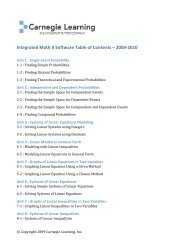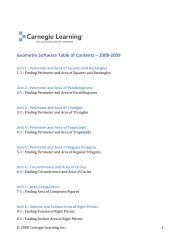IN_Standards for printing.xlsx - Carnegie Learning
IN_Standards for printing.xlsx - Carnegie Learning
IN_Standards for printing.xlsx - Carnegie Learning
Create successful ePaper yourself
Turn your PDF publications into a flip-book with our unique Google optimized e-Paper software.
G.1.1<br />
G.1.2<br />
G.1.3<br />
G.1.4<br />
Indiana Geometry<br />
Standard 1 Points, Lines, Angles and Planes<br />
Find the length of line segments in one‐ or two‐dimensional<br />
coordinate systems, the slopes of line segments in twodimensional<br />
coordinate systems, and find the point that is a<br />
given fractional distance from one end of the segment to<br />
another.<br />
Construct congruent segments and angles, angle bisectors,<br />
perpendicular bisectors, and parallel and perpendicular lines<br />
using appropriate geometric construction tools, explaining and<br />
justifying the process used.<br />
Recognize, use, and justify the relationships between special<br />
angles created by parallel lines and transversals.<br />
Identify and apply properties of and theorems about parallel and<br />
perpendicular lines, and write equations of parallel and<br />
perpendicular lines, and develop simple geometric proofs<br />
involving parallel and perpendicular lines.<br />
<strong>Carnegie</strong> <strong>Learning</strong> Source 1<br />
Text<br />
Software<br />
4.5, 4.6 18<br />
3.1, 5.3, 5.4, 5.6<br />
<strong>Carnegie</strong> <strong>Learning</strong> Resource Center:<br />
Basic Constructions<br />
5.1, 5.3 13, 19<br />
5.2, 5.3, 5.4<br />
G.1.5 Identify, justify and apply properties of planes. 5.1<br />
G.1.6<br />
Represent geometric objects and figures algebraically using<br />
coordinates, use algebra to solve geometric problems, and<br />
develop simple coordinate proofs involving geometric objects in<br />
5.5, 9.7<br />
the coordinate plane.<br />
G.1.7<br />
Describe the intersection of two or more geometric figures in the<br />
plane.<br />
12.2<br />
Standard 2 Polygons<br />
G.2.1<br />
G.2.2<br />
Find and use the sum of the measures of interior and exterior<br />
angles of convex polygons, justifying the method used.<br />
Identify types of symmetry (line, point, rotational, selfcongruences)<br />
of polygons.<br />
1.3, 9.5, 9.6<br />
6.1, 6.5 20<br />
G.2.3 Solve problems involving congruent and similar polygons. 7.1, 7.2, 7.3, 7.4, 8.1, 8.2, 8.3, 8.4 21<br />
G.2.4<br />
G.2.5<br />
G.2.6<br />
G.2.7<br />
G.2.8<br />
Predict and describe the results of translations, reflections, and<br />
rotations on polygons and describe a motion or series of motions<br />
that will show that two shapes are congruent.<br />
Deduce <strong>for</strong>mulas relating lengths and sides, perimeters, and<br />
areas of regular polygons and understand how limiting cases of<br />
such <strong>for</strong>mulas lead to expressions <strong>for</strong> the circumference and the<br />
area of a circle.<br />
Recognize and use coordinate geometry to verify properties of<br />
polygons such as regularity, congruence and similarity.<br />
Develop simple geometric proofs involving congruent and similar<br />
polygons and provide reasons <strong>for</strong> each statement.<br />
Quadrilaterals<br />
Describe, classify, and recognize relationships among the<br />
quadrilaterals such as squares, rectangles, rhombuses,<br />
parallelograms, trapezoids and kites.<br />
6.1, 6.2, 6.3, 6.4 20<br />
9.7<br />
7.2<br />
9.1, 9.2, 9.3, 9.4 22, 23, 24, 25
G.2.9<br />
G.2.10<br />
G.2.11<br />
Indiana Geometry<br />
Prove and apply theorems about parallelograms and trapezoids<br />
(including isosceles trapezoids) involving their angles, sides, and<br />
diagonals and prove that given quadrilaterals are parallelograms,<br />
rhombuses, rectangles, squares, or trapezoids (as appropriate).<br />
Triangles<br />
Define, identify, construct, and solve problems involving<br />
perpendicular bisectors, angle bisectors, medians and altitudes<br />
in triangles.<br />
Construct triangles congruent to given triangles, explaining and<br />
justifying the process used.<br />
<strong>Carnegie</strong> <strong>Learning</strong> Source 1<br />
Text<br />
Software<br />
9.2, 9.3, 9.4<br />
5.6, 5.7<br />
<strong>Carnegie</strong> <strong>Learning</strong> Resource Center:<br />
Triangle Constructions<br />
G.2.12<br />
Use theorems to show whether two triangles are congruent (SSS,<br />
SAS, ASA) or similar (AA, SAS, SSS).<br />
7.2, 7.3, 8.1, 8.2, 8.3, 8.4, 8.5<br />
G.2.13 Apply the triangle inequality theorem. 3.5<br />
G.2.14<br />
Develop simple geometric proofs involving triangles and provide<br />
reasons <strong>for</strong> each statement.<br />
3.3, 3.4, 3.5, 5.4, 5.5, 5.6, 5.7 14, 15<br />
Isosceles Triangles<br />
G.2.15 Prove and apply the isosceles triangle theorem and its converse. 4.3 17<br />
Right Triangles<br />
G.2.16<br />
G.2.17<br />
G.2.18<br />
G.2.19<br />
G.2.20<br />
Prove the Pythagorean Theorem and its converse and use them<br />
to solve problems, including problems involving the length of a<br />
segment in the coordinate plane.<br />
Prove and apply the relationships that exist when the altitude is<br />
drawn to the hypotenuse of a right triangle.<br />
Use special right triangles (30° ‐ 60° and 45° ‐ 45°) to solve<br />
problems.<br />
Define and use the trigonometric functions (sine, cosine,<br />
tangent) in terms of angles of right triangles.<br />
Deduce and apply the area <strong>for</strong>mula A =1/2 ab sinC, where a and<br />
b are the lengths of two sides of a triangle and C is the measure<br />
of the included angle <strong>for</strong>med by the two sides.<br />
4.2 16<br />
8.4<br />
4.3, 4.4 17<br />
11.1, 11.2, 11.3, 11.4 29<br />
G.2.21<br />
G.3.1<br />
G.3.2<br />
Solve problems that can be modeled using right triangles,<br />
including problems that can be modeled using trigonometric<br />
functions. Interpret the solutions, and determine whether the<br />
solutions are reasonable, using technology as when appropriate.<br />
Standard 3 Circles<br />
Construct the circle that passes through three given points not<br />
on a line and construct tangents to circles and circumscribe and<br />
inscribe circles, justifying the processes used.<br />
Define, deduce and use <strong>for</strong>mulas <strong>for</strong>, and prove theorems <strong>for</strong><br />
radius, diameter, chord, secant, and tangent.<br />
11.1, 11.2, 11.3, 11.4 29<br />
10.2, 10.4, 10.5, 12.1<br />
10.1 27
G.3.3<br />
Indiana Geometry<br />
Define, deduce and use <strong>for</strong>mulas <strong>for</strong>, and prove theorems <strong>for</strong><br />
measures of arcs and related angles (central, inscribed, and<br />
intersections of secants and tangents).<br />
<strong>Carnegie</strong> <strong>Learning</strong> Source 1<br />
Text<br />
Software<br />
10.2, 10.3, 10.5 26, 28<br />
G.3.4<br />
G.3.5<br />
G.3.6<br />
G.4.1<br />
Define, deduce and use <strong>for</strong>mulas <strong>for</strong>, and prove theorems <strong>for</strong><br />
measures of circumference, arc length, and areas of circles and<br />
sectors.<br />
Find the equation of a circle in the coordinate plane in terms of<br />
its center and radius and determine how the graph of a circle<br />
changes if a, b, and r are changed in the equation (x – a)2 + (y –<br />
b)2 = r2.<br />
Develop simple geometric proofs involving circles and provide<br />
reasons <strong>for</strong> each statement.<br />
Standard 4 Polyhedra and Other Solids<br />
Identify, justify and apply properties of prisms, regular pyramids,<br />
cylinders, right circular cones and spheres.<br />
1.6, 10.6, 10.7 5<br />
<strong>Carnegie</strong> <strong>Learning</strong> Resoure Center:<br />
Circles in the Coordinate Plane<br />
10.1, 10.2, 10.3, 10.4, 10.5, 10.6, 10.7<br />
2.2, 2.3, 2.4, 2.5, 2.6, 2.7, 2.8, 12.4<br />
G.4.2 Solve problems involving congruent and similar solids. 7.5<br />
8, 9, 10, 11,<br />
12, 31<br />
8, 9, 10, 11,<br />
12<br />
G.4.3<br />
Find and use measures of sides, volumes, and surface areas of<br />
prisms, regular pyramids, cylinders, right circular cones and<br />
spheres. Relate these measures to each other using <strong>for</strong>mulas.<br />
2.1, 2.2, 2.3, 2.4, 2.5, 2.6, 2.7, 2.8<br />
G.4.4<br />
Visualize solids and surfaces in three‐dimensional space when<br />
given twodimensional representations and create twodimensional<br />
representations <strong>for</strong> the surfaces of threedimensional<br />
objects.<br />
Standard 5 Geometric Reasoning and Proof<br />
12.2, 12.3, 12.5<br />
G.5.1<br />
Describe the structure of and relationships within an axiomatic<br />
system (undefined terms, definitions, axioms/postulates,<br />
methods of reasoning, and theorems).<br />
4.2, 5.2, 8.2, 8.3, 8.4<br />
G.5.2<br />
Recognize that there are geometries, other than Euclidean<br />
geometry, in which the parallel postulate is not true and<br />
illustrate its counterparts in other geometries.<br />
G.5.3<br />
Understand the difference between supporting evidence,<br />
counterexamples, and actual proofs.<br />
<strong>Carnegie</strong> <strong>Learning</strong> Resouce Center:<br />
* Introduction to Logical Principls<br />
* What's Your Conclusion<br />
* Conditional Statements<br />
* Number Proofs<br />
G.5.4<br />
Develop simple geometric proofs (direct proofs, indirect proofs,<br />
proofs by contradiction and proofs involving coordinate<br />
geometry) using two‐column, paragraphs, and flow charts<br />
<strong>for</strong>mats and providing reasons <strong>for</strong> each statement in the proofs.<br />
3.2, 3.3, 3.5, 4.2, 4.3, 4.4, 4.5, 4.6, 5.2,<br />
5.3, 5.5, 5.6, 7.3, 8.2, 8.3, 8.4, 8.5, 9.2,<br />
9.3, 9.4, 9.5, 9.6, 12.1<br />
15<br />
1 See Text and Software Table of Contents <strong>for</strong> Titles


